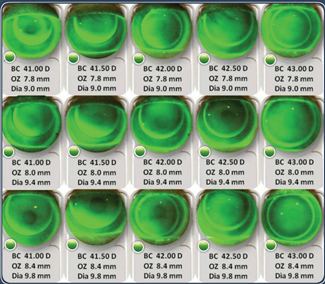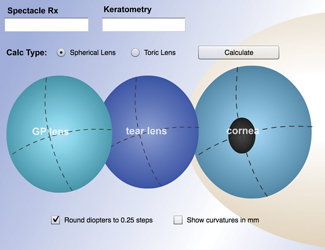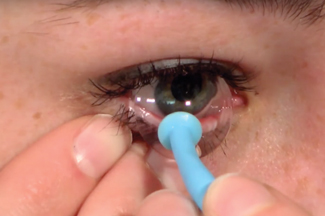Although many thought rigid gas permeable (GP) contact lenses were on their way out when soft contact lenses came to dominate the market in the 90s and early 2000s, innovation and technology have kept them alive and relevant.1-2 Today, they are an effective route to better vision and long-term comfort, as well as reduced risk of sight-threatening complications.2
Despite their utility, many practitioners still shy away from prescribing GP lenses in their practices. While learning how to fit patients for GP lenses may seem like a daunting task, there is an abundance of industry resources available to make adding them to your toolbox easier. And better yet, many of these resources are available right at your fingertips.
“Some of the best resources for GP lenses, including scleral lenses, can be found online,” says Heidi Miller, OD, of UC Davis Eye Center in Sacramento, Calif.
Here is a closer look at what’s out there to help practitioners add GP lenses to their repertoires.
 |
| Fig. 1. GPLI’s “Click N’ Fit” online diagnostic fitting set gives practitioners a way to fit GP lenses interactively before trying the real thing. Image: Edward S. Bennett, OD |
The GP Lens Institute
Since starting out as a seminar sponsor, the GP Lens Institute (GPLI)—the educational division of the Contact Lens Manufacturers Association (CLMA)—has branched out to an all-encompassing resource with online webinars, educational materials for practitioners and more.3 According to GPLI Executive Director Edward S. Bennett, OD, the goal is to serve as the “go-to resource for GP and custom soft lens clinical education.”
Many of the GPLI’s resources are available on its website, www.gpli.info. These include:3
• More than 65 archived webinars by renowned specialty lens fitters covering crucial topics related to GPs.
• A coding and billing module under the direction of Clarke Newman, OD. This includes a webinar, as well as FAQs, letters and pamphlets to use for reimbursement purposes.
• A grand rounds troubleshooting guide featuring 52 case reports to show how specific GP designs (i.e., spherical, toric) can be successful.
• A staff training module to help practitioners guide their personnel in educating patients about different types of contact lenses. In addition to a detailed guide, the module features training videos and webinars.
• A collection of laboratory consultant FAQs covering the most common questions asked of laboratory consultants and their responses.
• A searchable lens database for practitioners to browse and compare available options. According to Dr. Bennett, this is a “‘Tyler’s Quarterly’ of GP lens designs.”
• A GP specialist database for practitioners to help relocating patients find a GP lens specialist when they move.
• Consumer brochures on topics such as sclerals, multifocals, corneal reshaping and lens care.
The website also allows practitioners to narrow down their resource search results by lens type from the following categories: bitoric/high astigmatism, corneal reshaping, keratoconus/post-surgical, presbyopia/multifocals, scleral lenses, soft specialty lenses and spherical GP lenses.3
“Under the spherical GP category there are a number of different resources, some of which are ideal for students and practitioners desiring to have a very good understanding of the basics of GP fitting and evaluation,” says Dr. Bennett. “For example, ‘Click N’ Fit’ consists of a 15-lens diagnostic fitting set with varying base curve radii and overall/optical zone diameters, for which you can select to perform a virtual fitting on a patient” (Figure 1). Another of Dr. Bennett’s recommendations under the spherical GP lens category is “GP Fitting, Evaluation and Problem-Solving,” an interactive, video-based tool that delves into fluorescein patterns and how to work through common GP problems such as decentration, surface wettability and desiccation.3
The bitoric/high astigmatism tab features several empirical bitoric guides and calculators. The GPLI Toric and Spherical Lens Calculator, for example, provides lens design parameters for recommended bitoric or spherical lenses after the user enters refraction and keratometry values (Figure 2).3
Among the resources found under the presbyopia/multifocals tab is a module on “Building Your Practice with GP Bifocals and Multifocals.”3 This includes videos and documents about GP multifocal fitting, evaluation and patient education on lens insertion and removal, as well as a fee calculator.
The scleral tab includes a number of scleral lens-related webinars, and “Scleral Lens Troubleshooting FAQs,” a guide with over 110 photos dedicated to scleral lens fitting, care and problem-solving.3
The Scleral Lens Education Society
For practitioners looking to learn how to prescribe scleral lenses specifically, the Scleral Lens Education Society (SLS) is a valuable resource.4 Like GPLI, SLS serves as something of a go-to resource for all things scleral lenses, and the SLS website, www.sclerallens.org, contains a multitude of educational content for its members:4
• A “living library” of up-to-date, peer-reviewed research. “The research library is a great way to share with other providers,” says Melissa Barnett, OD, SLS immediate past president. “For example, practitioners can share information about scleral lenses for keratoconus with a corneal specialist or scleral lenses for Sjögren’s syndrome with a rheumatologist.”
• A searchable scleral lens fitter database with the option to narrow the list down by state. The database is solely made up of practitioners who have completed an SLS fellowship, meaning they have proven their proficiency in scleral lens fitting, evaluation and patient management.
• A “For Patients” section contains scleral lens use instructions, FAQs, relevant links and more. Practitioners can send their new scleral lens patients here for quick, at-home answers.
• Audio presentations and webinars from top experts in the field cover topics such as fitting basics, billing and coding and answers to commonly asked questions.
• Written information and FAQs on scleral lens indications, selection, complications and care are quick resources for practitioners with specific questions.
Among SLS’s most popular resources is an all-encompassing video on scleral lens insertion, removal, troubleshooting and lens care, which can be found on the SLS homepage (Figure 3).4 “This video is widely shared on websites and is helpful for patients, practitioners and staff prior to the in-office dispense appointment,” says Dr. Barnett. SLS also offers a quiz to introduce practitioners to scleral lenses.4
Labs and Consultants
One of the most helpful ways for practitioners to get started with GP lenses is to contact laboratories and their consultants. “There is no question so simple that a laboratory consultant has not heard it before, and they will assist you through the entire lens selection, fitting and problem-solving process,” says Dr. Bennett. “This could be a routine evaluation of a current GP wearer, a potential multifocal fit, an irregular cornea patient in need of GP lenses, a bitoric for high astigmatism or a scleral lens.”
In addition, “each manufacturer will have their own certification video tailored to their scleral design that must be completed prior to fitting,” Dr. Miller adds.
Using online calculators such as GPLI’s Toric and Spherical Lens Calculator, practitioners can fit spherical, bitoric and aspheric multifocal lenses empirically.5 “This, of course, makes GP fitting very simple,” says Dr. Bennett. “The consultant can provide diagnostic fitting sets, as well as useful advice on problem-solving all types of GP lens designs.” Laboratory consultants also offer in-office, hands-on training, says Dr. Barnett.
Another option is to use a smart phone-slit lamp adapter to take photos and video of the GP fitting relationship and send them to the laboratory. If corneal topography is available for the patient, sending it to the laboratory can also be a big help.
 |
| Fig. 2. The GPLI Toric and Spherical Lens Calculator gives practitioners lens design parameters for bitoric or spherical lens recommendations. Image: The GP Lens Institute |
Selecting a Lab
Today, choosing a quality GP lens laboratory is easier than ever before. “One of the great blessings today is that, although there are not as many laboratories as there were 10 to 20 years ago, the laboratories available today typically make consistent, high-quality GP lenses,” says Dr. Bennett. “Problems with inconsistent edge quality, poor initial surface wettability, less-than-optimal optics on toric lenses have all but disappeared.”
Also, “one of the hallmarks of the laboratories in existence today is the desire to work closely with each eye care practitioner to make them comfortable and successful in fitting GP lenses,” says Dr. Bennett.
Here are some of the most imperative qualities to look for when on the hunt for a GP lens laboratory:
• A CLMA membership. These laboratories must pass a stringent quality control program.6 “Whenever you hear of a highly recommended specialty GP design, it is very likely that it is manufactured from a CLMA member laboratory,” says Dr. Bennett.
• Lens types. While all laboratories produce multifocal, irregular cornea and scleral lens designs, the design that you’re looking for—whether it be a specific multifocal lens, a keratoconic or post-surgical lens or a scleral lens—may only be made by a limited number of laboratories, so it is prudent to make this a priority in your search.
• Peer recommendations. Looking to your colleagues when making your laboratory decision can make the process much easier. “Fortunately, every region of the country has numerous high-quality laboratories to choose from, and it is very highly recommended that you use GP designs manufactured from as many as three or more laboratories,” says Dr. Bennett. As such, peer recommendations can be invaluable when deciding which laboratories to create accounts with.
• Service, warranties, etc. Quick turnaround on GP lenses is important to compete with soft lenses, so selecting a laboratory that can keep up is important. By the same token, warranty and exchange programs vary by lens type, so practitioners should be sure that the laboratory they choose has a program that will work for their patients.
• Available resources. If a laboratory has a high-quality online help interface, chances are it is a high-quality laboratory, says Dr. Bennett. Look for easy access to conversion charts, webinars discussing lens fit scales, troubleshooting guides, searchable databases, detailed FAQs and anything else relevant to the questions you may have. Practitioners can find a list of CLMA member laboratories, including many with available resources, in GLPI’s Specialty Lab Directory.3
Meetings and Conferences
SLS provides COPE-approved education through lectures, webinars and workshops at annual meetings such as the American Academy of Optometry, Vision Expos East and West and Vision By Design.4 According to Dr. Barnett, “workshops with hands-on training are an ideal way to learn.”
New for this year is the GPLI-sponsored GPLIwire2017: The Virtual Specialty Lens Conference.7 Billed as “the first online continuing education event focused exclusively on specialty contact lens education,” the entirety of this COPE-approved conference will be available on-demand until December 1, 2017, for practitioners who can’t make it to the conference in person.7 Coursework covers scleral lenses, orthokeratology, custom soft lenses, presbyopia, hybrid lenses, ocular condition management with contact lenses and specialty contact lens fitting instrumentation.7
For practitioners looking to cover all their bases at one meeting, Dr. Barnett believes the Global Specialty Lens Symposium (GSLS) is “one of the best meetings for scleral lenses in the United States.” While GSLS focuses on the full spectrum of today’s specialty lenses, Dr. Barnett notes that its scleral lens coverage is especially expansive, often featuring introductions to new scleral lens designs and technology.8
Another new meeting on the circuit is the International Congress of Scleral Contacts, which just completed its second annual run on July 28, 2017.9 Dedicated entirely to scleral lenses, this full-day meeting gives practitioners information all over the scleral landscape. This year’s topics included scleral technology, marketing, ocular surface complications, an ophthalmology perspective and more.9
Also a scleral-exclusive meeting, the International Forum for Scleral Lens Research focuses on evidence-based information about scleral lenses.10 One of this meeting’s main purposes is to address the lack of consensus surrounding scleral lenses.10
Other international meetings that cover specialty contact lenses include the British Contact Lens Association, the Cornea & Contact Lens Society of Australia and the Netherlands Contact Lens Congress.11-13
 |
| Fig. 3. The SLS homepage features a video that walks users through the basics of scleral lens insertion, removal, troubleshooting and lens care. Image: The Scleral Lens Education Society |
Additional Resources
Some other tools available to practitioners include:
• “A Guide to Scleral Lens Fitting” by scleral lens expert Eef van der Worp provides a “general understanding on everything you need to know about scleral lenses,” according to Dr. Miller.14 A free, downloadable version of this book is available through Pacific University at http://commons.pacificu.edu/mono/4.14
• Scleral Lens Fit Scales, available through Ferris State University’s website, are a helpful way to “demonstrate how to correctly estimate clearance by comparing the tear layer thickness with the center thickness of the lens,” says Dr. Barnett.15 The scales feature example photos of central vaulting, limbal vaulting and edge relationship to provide “visual examples on what to look for behind a slit lamp when fitting a scleral lens,” says Dr. Miller.15
While these resources can give practitioners a solid basis on which to build their GP lens practices, it is up to the individual to keep up with the necessary steps for successful lens fitting. “Whichever resources you choose, it is important to develop a strong understanding on how to appropriately fit each type of GP lens,” says Dr. Miller. “Following the fit guides provided by each company and using the specialty lens consultants from each manufacturer will help develop the confidence and efficiency to manage a variety of patients with specialty GP lenses.”
1. Efron N. Contact lens practice and a very soft option. Qin Exp Optom. 2000;83(5):243-5.
2. Gill FR. Turning the tide for gas permeable contact lenses. Cardiff University. 2010. orca.cf.ac.uk/54980/1/U585369.pdf. Accessed August 4, 2017.
3. GP Lens Institute. www.gpli.info. Accessed August 4, 2017.
4. The Scleral Lens Education Society. www.sclerallens.org.
5. GPLI Toric and Spherical Lens ulator. www.gpli.info/lens-calculator. Accessed August 4, 2017.
6. Code of Ethics. Contact Lens Manufacturers Association. www.clma.net/about-the-clma. Accessed August 4, 2017.
7. GPLIwire2017: The Virtual Specialty Lens Conference. www.vconferenceonline.com/microsite/html/event.aspx?id=1296. Accessed August 7, 2017.
8. Global Specialty Lens Symposium. www.gslsymposium.com. Accessed August 4, 2017.
9. International Congress of Scleral Contacts. www.icscmeeting.com. Accessed August 7, 2017.
10. International Forum for Scleral Lens Research. University of Houston College of Optometry. ce.opt.uh.edu/live/2017/international-forum-for-scleral-lens-research1. Accessed August 8, 2017.
11. British Contact Lens Association. www.bcla.org.uk. Accessed August 8, 2017.
12. Cornea & Contact Lens Society of Australia. www.cclsa.org.au. Accessed August 8, 2017.
13. Netherlands Contact Lens Congress. ncc2018.com. Accessed August 8, 2017.
14. van der Worp E. A Guide to Scleral Lens Fitting [monograph online]. Forest Grove, OR: Pacific University; 2010. commons.pacificu.edu/mono/4. Accessed August 4, 2017.
15. Lotoczky J, Rosen C, Norman CW. Scleral Lens Fit Scales. Ferris State University Michigan College of Optometry Vision Research Institute. 2014. www.ferris.edu/HTMLS/colleges/michopt/vision-research-institute/pdfs-docs/Scleral-lens-fit-scales_v2.pdf. Accessed August 4, 2017.


